Effective Project Risk and Stakeholder Management Strategies
VerifiedAdded on 2020/07/22
|41
|13868
|128
Essay
AI Summary
Managing project risks and stakeholders is crucial for the successful completion of any project. This essay explores the importance of early identification and assessment of potential risks using tools such as risk matrices and SWOT analysis. It discusses strategies to mitigate these risks, including contingency planning and adaptive management. The role of stakeholder engagement is emphasized, highlighting techniques for effective communication and relationship building. Tools like stakeholder mapping and regular updates ensure that stakeholders are well-informed and supportive throughout the project lifecycle. By integrating both risk management and stakeholder engagement practices, projects can achieve higher success rates with reduced uncertainties.

Manage Project Time
Paraphrase This Document
Need a fresh take? Get an instant paraphrase of this document with our AI Paraphraser

TABLE OF CONTENTS
INTRODUCTION...........................................................................................................................1
FORMATIVE ASSESSMENT........................................................................................................1
ACTIVITY 1....................................................................................................................................1
Q1.Definition of ADP............................................................................................................1
Q2. Four components which are related with WBS...............................................................2
Q3.Difference among an activity and WBS...........................................................................3
Q.4 Three sequences and state in a activity............................................................................4
Q.5 Process of activity sequencing procedures......................................................................5
Q6.Different consideration which are estimated in duration and effort sequences................5
Q7: Four approaches to precedence diagram.........................................................................6
Q8: Eight tools and techniques that are used in project schedule..........................................6
Q9: Meaning of AREP...........................................................................................................7
Q10; Lists of event which have made impact of project scheduling......................................7
Q11: Schedule baseline..........................................................................................................8
Q12. List of activities required for moving house..................................................................8
Q13: Create a project schedule for moving house..................................................................9
ACTIVITY 2..................................................................................................................................10
Q1: Process of schedule development..................................................................................10
Q2: Tools and techniques used for schedule development .................................................11
Q3: Time constraints on project schedule............................................................................11
Q4: Critical path...................................................................................................................11
Q5: Project baseline..............................................................................................................12
Q6; Schedule compression...................................................................................................12
Q7: Create a baseline report.................................................................................................12
Q8: Create a baseline variance report...................................................................................13
Q9: Impact of the changes which are made in a schedule....................................................14
Q10: List five changes that are having huge impact on project time management..............15
Q11: Create a report with the use of critical path.................................................................15
Q12: Impact of approved changes on project time management.........................................18
INTRODUCTION...........................................................................................................................1
FORMATIVE ASSESSMENT........................................................................................................1
ACTIVITY 1....................................................................................................................................1
Q1.Definition of ADP............................................................................................................1
Q2. Four components which are related with WBS...............................................................2
Q3.Difference among an activity and WBS...........................................................................3
Q.4 Three sequences and state in a activity............................................................................4
Q.5 Process of activity sequencing procedures......................................................................5
Q6.Different consideration which are estimated in duration and effort sequences................5
Q7: Four approaches to precedence diagram.........................................................................6
Q8: Eight tools and techniques that are used in project schedule..........................................6
Q9: Meaning of AREP...........................................................................................................7
Q10; Lists of event which have made impact of project scheduling......................................7
Q11: Schedule baseline..........................................................................................................8
Q12. List of activities required for moving house..................................................................8
Q13: Create a project schedule for moving house..................................................................9
ACTIVITY 2..................................................................................................................................10
Q1: Process of schedule development..................................................................................10
Q2: Tools and techniques used for schedule development .................................................11
Q3: Time constraints on project schedule............................................................................11
Q4: Critical path...................................................................................................................11
Q5: Project baseline..............................................................................................................12
Q6; Schedule compression...................................................................................................12
Q7: Create a baseline report.................................................................................................12
Q8: Create a baseline variance report...................................................................................13
Q9: Impact of the changes which are made in a schedule....................................................14
Q10: List five changes that are having huge impact on project time management..............15
Q11: Create a report with the use of critical path.................................................................15
Q12: Impact of approved changes on project time management.........................................18

ACTIVITY 3..................................................................................................................................18
Q1.List of schedule review...................................................................................................18
Q2: Schedule control process...............................................................................................18
Q3: Entailed in performance reviews...................................................................................19
Q4:Five documents which are required in review of time management..............................19
Q5: Three reports which are required for moving house project.........................................20
Q6: Results of change to schedule made prior.....................................................................22
SUMMATIVE ASSESSMENT 1..................................................................................................22
Q1: Two techniques used by project managers to determine task duration and effort........22
Q2: Procedure to identify critical path.................................................................................22
Q3: Process of managing project baseline...........................................................................23
Q4: Stages of life cycle.........................................................................................................23
Q5: Decomposition of time management.............................................................................23
Q6: Project management techniques in creating schedule...................................................24
Q7: WBS and it relation in to project schedule....................................................................24
SUMMATIVE ASSESSMENT 2..................................................................................................24
OBSERVATION REPORT...........................................................................................................27
Determine project schedule..................................................................................................27
Implement project schedule..................................................................................................33
Assess time management outcomes.....................................................................................35
CONCLUSION..............................................................................................................................36
REFERENCES..............................................................................................................................37
Q1.List of schedule review...................................................................................................18
Q2: Schedule control process...............................................................................................18
Q3: Entailed in performance reviews...................................................................................19
Q4:Five documents which are required in review of time management..............................19
Q5: Three reports which are required for moving house project.........................................20
Q6: Results of change to schedule made prior.....................................................................22
SUMMATIVE ASSESSMENT 1..................................................................................................22
Q1: Two techniques used by project managers to determine task duration and effort........22
Q2: Procedure to identify critical path.................................................................................22
Q3: Process of managing project baseline...........................................................................23
Q4: Stages of life cycle.........................................................................................................23
Q5: Decomposition of time management.............................................................................23
Q6: Project management techniques in creating schedule...................................................24
Q7: WBS and it relation in to project schedule....................................................................24
SUMMATIVE ASSESSMENT 2..................................................................................................24
OBSERVATION REPORT...........................................................................................................27
Determine project schedule..................................................................................................27
Implement project schedule..................................................................................................33
Assess time management outcomes.....................................................................................35
CONCLUSION..............................................................................................................................36
REFERENCES..............................................................................................................................37
⊘ This is a preview!⊘
Do you want full access?
Subscribe today to unlock all pages.

Trusted by 1+ million students worldwide

INTRODUCTION
Time management of project is a crucial aspects for an organisation by which they can
identify the total time required to complete a project. It also consists of various information such
time spent by individual or group on a project. In order to record total time spent by people, the
team implement a manage project time procedure (Alhawari and et. al., 2012). With the use of
time sheet all project time information are summarised and recorded according to the activities
performed during the year. It is considered as, that process of strategies and workout intended
control over the total time spent on particular activities. All these are done in order to enhance
effectiveness or productivity of an organisation. As, it can also be define as a non- repetitive
activity which are having various characteristics. The prime objectives of conducting a well
organised plan in accordance to determine the total time because to attain set goals. It will be
more effective to identify different ways of using resources and make proper utilisation of those
in a project.
However, its usefulness is to generate on time results with the use of right budget and
high quality initiatives that compete or meet our customer expectation. This project consists of
various parts which is based on various activities that explains different situations of a project. It
consists of schedule development process, tools and techniques which are used in development
process. Effect of time of a project is represented through using critical path. Impacts of various
changes which are related with the schedule are discussed under this project report.
The understanding of scheduled control process in context to managing project time. It
contains different documents which are required to assess project at the time review. Drawing
tools within a computer program are taken into consideration that explains crucial aspects of
projects. Different techniques used by project managers in the context of identifying duration of
task in a specific project (Bakker and et. al., 2011). Overall, this project assessment provides
complete overviews of time management which is required during a project planning.
FORMATIVE ASSESSMENT
ACTIVITY 1.
Q1.Definition of ADP
Activity definition process is use to identifying the particular action that is going to be
performed. The prime goal of the ADP is to ensure that project member should have complete
1
Time management of project is a crucial aspects for an organisation by which they can
identify the total time required to complete a project. It also consists of various information such
time spent by individual or group on a project. In order to record total time spent by people, the
team implement a manage project time procedure (Alhawari and et. al., 2012). With the use of
time sheet all project time information are summarised and recorded according to the activities
performed during the year. It is considered as, that process of strategies and workout intended
control over the total time spent on particular activities. All these are done in order to enhance
effectiveness or productivity of an organisation. As, it can also be define as a non- repetitive
activity which are having various characteristics. The prime objectives of conducting a well
organised plan in accordance to determine the total time because to attain set goals. It will be
more effective to identify different ways of using resources and make proper utilisation of those
in a project.
However, its usefulness is to generate on time results with the use of right budget and
high quality initiatives that compete or meet our customer expectation. This project consists of
various parts which is based on various activities that explains different situations of a project. It
consists of schedule development process, tools and techniques which are used in development
process. Effect of time of a project is represented through using critical path. Impacts of various
changes which are related with the schedule are discussed under this project report.
The understanding of scheduled control process in context to managing project time. It
contains different documents which are required to assess project at the time review. Drawing
tools within a computer program are taken into consideration that explains crucial aspects of
projects. Different techniques used by project managers in the context of identifying duration of
task in a specific project (Bakker and et. al., 2011). Overall, this project assessment provides
complete overviews of time management which is required during a project planning.
FORMATIVE ASSESSMENT
ACTIVITY 1.
Q1.Definition of ADP
Activity definition process is use to identifying the particular action that is going to be
performed. The prime goal of the ADP is to ensure that project member should have complete
1
Paraphrase This Document
Need a fresh take? Get an instant paraphrase of this document with our AI Paraphraser

knowledge of all the tasks that are related with project scope so that proper list of work can be
made. Like for example, in a project planning without of proper schedule of work design that
summarises of various information such as total estimation of time required by a project to
complete or what kind of resources a company is needed to formulate a report.
Q2. Four components which are related with WBS
Work breakdown structure is separation of various activities into small parts so that work
would complete in more effective and quick way (Bell, 2014). In a WBS different elements can
be product, data and a services or combination of both. It is provided valuable information
regarding cost estimation. In a project it has been found that in WBS, work package is lower
most level. It is achieved only when the cost is properly determine by taking cost and time at the
same point. It can be handled by appointing one individual who is known as work package
owner who is responsible for managing entire project. Components of WBS are nothing but a
collection of those activities that are associated with specific part of a project which is taken
during the process.
The four components which are used in WBS are explained underneath:
a) WBS task dictionary: It is considered as those task documents, which explains the
concepts for every component available in a work breakdown structure. According to dictionary,
it determines various tasks, it’s essential needs and time of completion and all other aspects
associated with a project. The primary objective of this dictionary is to provide well organised
structure information regarding each and every element which is used in a WBS. It is mainly
consists of work package and different control accounts related information. It plays an
important role in guiding concern person about the project which is implemented by an
organisation.
b) Multi-level task granulation: The information regarding a project is working as a
well identify different types of tasks which are categorised according to WBS. Under this, one
project is divided into various tasks and sub tasks so that more accurate and reliable results can
be achieved. It is said to be multi-level because at one time more than one activity can be
performed by an organisation. All the resources are used in such a ways that necessary outcome
can be attain from each units which is divided according to WBS. Necessary inputs are
implemented in the tasks by which a project manager can achieve better results.
2
made. Like for example, in a project planning without of proper schedule of work design that
summarises of various information such as total estimation of time required by a project to
complete or what kind of resources a company is needed to formulate a report.
Q2. Four components which are related with WBS
Work breakdown structure is separation of various activities into small parts so that work
would complete in more effective and quick way (Bell, 2014). In a WBS different elements can
be product, data and a services or combination of both. It is provided valuable information
regarding cost estimation. In a project it has been found that in WBS, work package is lower
most level. It is achieved only when the cost is properly determine by taking cost and time at the
same point. It can be handled by appointing one individual who is known as work package
owner who is responsible for managing entire project. Components of WBS are nothing but a
collection of those activities that are associated with specific part of a project which is taken
during the process.
The four components which are used in WBS are explained underneath:
a) WBS task dictionary: It is considered as those task documents, which explains the
concepts for every component available in a work breakdown structure. According to dictionary,
it determines various tasks, it’s essential needs and time of completion and all other aspects
associated with a project. The primary objective of this dictionary is to provide well organised
structure information regarding each and every element which is used in a WBS. It is mainly
consists of work package and different control accounts related information. It plays an
important role in guiding concern person about the project which is implemented by an
organisation.
b) Multi-level task granulation: The information regarding a project is working as a
well identify different types of tasks which are categorised according to WBS. Under this, one
project is divided into various tasks and sub tasks so that more accurate and reliable results can
be achieved. It is said to be multi-level because at one time more than one activity can be
performed by an organisation. All the resources are used in such a ways that necessary outcome
can be attain from each units which is divided according to WBS. Necessary inputs are
implemented in the tasks by which a project manager can achieve better results.
2

c) Top level deliverable design: It has been found that WBS is providing a common
framework from a particular project (Caputo and et. al., 2013). It is for practical development of
a planning and controlling of a contract. It is used to divide work into definable increments
among which a total structure of work can be identified. It is summarised with certain aspects
such as cost, labour used in it and schedule of work. The structure is of top level so that work
cannot get disturbed and resources can be utilised in more effective manners. The work under
WBS is organised as primary product rather than of work required to produce the products.
d) Descriptor of task and activities: According to this component, all the information
regarding different tasks and activities are recorded into a set pattern. It will help to identify
which task is taking how much time to complete and use of total resources. Project managers can
determine necessary adjustment according to those tasks which are lacking behind and not able
to work according to the set plan. The overall description of entire work is summarising with
relation to its cost and time requires in completing them. On the basis of collected information,
necessary changes are made by using corrective methods and tools.
Q3.Difference among an activity and WBS
Activity list Work breakdown structure
It is an essential aspect of an itemized
certification of different kind of schedule
activities which are considered as a part of a
specific project.
Splitting of activities into various segments are
so that accurate results of outcomes can be
achieved.
It consists of various name of activity with its
description.
WBS is structured base on various Tasks and
sub-projects description.
The lists of various activities can be modified
as per the requirement of project demand.
It is set pattern which summarises of various
tasks allotted to a each employees to get most
benefits out of it.
Activities list is said to be a list of what kind of
work operation a company is going to do.
WBS is a summary of what company is going
to make.
Most of the details are set prior staring of a WBS is also made before a project plan but
3
framework from a particular project (Caputo and et. al., 2013). It is for practical development of
a planning and controlling of a contract. It is used to divide work into definable increments
among which a total structure of work can be identified. It is summarised with certain aspects
such as cost, labour used in it and schedule of work. The structure is of top level so that work
cannot get disturbed and resources can be utilised in more effective manners. The work under
WBS is organised as primary product rather than of work required to produce the products.
d) Descriptor of task and activities: According to this component, all the information
regarding different tasks and activities are recorded into a set pattern. It will help to identify
which task is taking how much time to complete and use of total resources. Project managers can
determine necessary adjustment according to those tasks which are lacking behind and not able
to work according to the set plan. The overall description of entire work is summarising with
relation to its cost and time requires in completing them. On the basis of collected information,
necessary changes are made by using corrective methods and tools.
Q3.Difference among an activity and WBS
Activity list Work breakdown structure
It is an essential aspect of an itemized
certification of different kind of schedule
activities which are considered as a part of a
specific project.
Splitting of activities into various segments are
so that accurate results of outcomes can be
achieved.
It consists of various name of activity with its
description.
WBS is structured base on various Tasks and
sub-projects description.
The lists of various activities can be modified
as per the requirement of project demand.
It is set pattern which summarises of various
tasks allotted to a each employees to get most
benefits out of it.
Activities list is said to be a list of what kind of
work operation a company is going to do.
WBS is a summary of what company is going
to make.
Most of the details are set prior staring of a WBS is also made before a project plan but
3
⊘ This is a preview!⊘
Do you want full access?
Subscribe today to unlock all pages.

Trusted by 1+ million students worldwide

project. they need to be follow according to durability
of units.
Q.4 Three sequences and state in a activity
Activity sequencing is the procedures for identifying and preparing necessary
documentation regarding dependencies between programme activities (Crawford, 2014). There is
a situation which is related with a external dependency that are originated from external sources
of the projects. They are interpreted into consideration while developing various activities into a
set format. The term activity sequencing is considered as those aspects of a project management
which is having dual impact. In the beginning of a project plan these activity sequencing consists
of various process of ideas that are ordered in a serial of activities. It is used to review all the
activities in the work breakdown structure with definite objectives of determining a perfect
relationship among them. It also classifies timing that an activity is taking in that context. Timing
of tasks are more important because the sequence of activities are controlled and start-to-finish
timing can be determined. In some situation they are logical as well as mandatory. Like for an
example, during a project that consists of design and development of a custom web based
application system. Under this, it is essential to accomplish user requirements that are related to a
particular task before starting that application system in actions. The lists of sequencing that are
related with the activities are:
a) Impact of start-to-finish times and dates relationship: According to this
sequencing, one activity must complete before another activity begun. Other aspects state that
one activity cannot start until activities get completed. When a new task is added to a schedule it
directly related to a schedule to start on a particular project's with a start data. As tasks are
related with a scheduled and connected to each other tasks. The timing of starts tasks can be
changes according to the requirement of a project. The tasks dependencies can indicate relation
among time of a one single task in relation to other. Connections of two tasks are considered as
dependencies.
b) Logical, preferred or required order of task: In order to manage project in
accordance to minimise the cost. Some of the logical steps need to be taken in considered as per
the sequences decided by the mangers (Dille and Söderlund, 2011). It is very difficult task but
more effective results can only be possible through using right techniques in a project. The
dependencies are categories into three segments such as mandatory which is determine by nature
4
of units.
Q.4 Three sequences and state in a activity
Activity sequencing is the procedures for identifying and preparing necessary
documentation regarding dependencies between programme activities (Crawford, 2014). There is
a situation which is related with a external dependency that are originated from external sources
of the projects. They are interpreted into consideration while developing various activities into a
set format. The term activity sequencing is considered as those aspects of a project management
which is having dual impact. In the beginning of a project plan these activity sequencing consists
of various process of ideas that are ordered in a serial of activities. It is used to review all the
activities in the work breakdown structure with definite objectives of determining a perfect
relationship among them. It also classifies timing that an activity is taking in that context. Timing
of tasks are more important because the sequence of activities are controlled and start-to-finish
timing can be determined. In some situation they are logical as well as mandatory. Like for an
example, during a project that consists of design and development of a custom web based
application system. Under this, it is essential to accomplish user requirements that are related to a
particular task before starting that application system in actions. The lists of sequencing that are
related with the activities are:
a) Impact of start-to-finish times and dates relationship: According to this
sequencing, one activity must complete before another activity begun. Other aspects state that
one activity cannot start until activities get completed. When a new task is added to a schedule it
directly related to a schedule to start on a particular project's with a start data. As tasks are
related with a scheduled and connected to each other tasks. The timing of starts tasks can be
changes according to the requirement of a project. The tasks dependencies can indicate relation
among time of a one single task in relation to other. Connections of two tasks are considered as
dependencies.
b) Logical, preferred or required order of task: In order to manage project in
accordance to minimise the cost. Some of the logical steps need to be taken in considered as per
the sequences decided by the mangers (Dille and Söderlund, 2011). It is very difficult task but
more effective results can only be possible through using right techniques in a project. The
dependencies are categories into three segments such as mandatory which is determine by nature
4
Paraphrase This Document
Need a fresh take? Get an instant paraphrase of this document with our AI Paraphraser

of a project demand. Second is discretionary dependency, it is used to managers according to the
tasks schedule. Last is external dependency which is based on external factors those are affecting
the project.
c) Milestones of delivery: It is said to be that tools which is used in a project time
management to mark a particular project stages along with a time deadline. It represents start-to-
finish date or a project. It is considered as those stages which are achieved with a project
completed or reached at its final stages. Some of the major aspects are based on short or long
term aims and objectives of a company in attaining the goals and removing various challenges
that are associated in a project planning. A perfect plan for a project can provided more accurate
results which is considered as milestones for a project managers.
Q.5 Process of activity sequencing procedures
It is considers as process of designing a network diagram and using activity lists form
that of activity stages (Heagney, 2016). A network diagram is a numerical display that explains
different activities in a project planning as well as its sequential coordination. If we, determine a
proper sequence of activity, it is necessary to have few position for activities that can be utilise
parallel to fixed scheduled. It is done in order to achieve faster completion of projects. After
determining necessary schedule for an activity, it is important to arrange them in a proper logical
orders and identify whether any dependencies exists in those activities.
The logical relationships must be arranged in order to enhance the alteration of a realistic,
gettable project schedule in a later procedures. In the process of activity sequencing, it is
important to utilise a host to inputs and tools or techniques in order to generate valuable outputs.
It is related with scope of statements, lists of activities, attitudes, milestones and various changes.
In case of successor or predecessor, each activity and milestones are joined together expect the
first and last activity in an projects. It is important that can be used in relation with the lead and
lag time among various activities that supports a real and marketable project schedule.
Q6.Different consideration which are estimated in duration and effort sequences
A project is known as series of unique, complex condition. Estimating different activity
duration is all about generating out essential efforts needed in order to complete each activity.
The total amounts of resources which are required for conducting a well planned activity are
determined in a specific project. It will help to identify the total time required to finish a project.
In the success of a project the last one thing required is the level of skills and knowledge for each
5
tasks schedule. Last is external dependency which is based on external factors those are affecting
the project.
c) Milestones of delivery: It is said to be that tools which is used in a project time
management to mark a particular project stages along with a time deadline. It represents start-to-
finish date or a project. It is considered as those stages which are achieved with a project
completed or reached at its final stages. Some of the major aspects are based on short or long
term aims and objectives of a company in attaining the goals and removing various challenges
that are associated in a project planning. A perfect plan for a project can provided more accurate
results which is considered as milestones for a project managers.
Q.5 Process of activity sequencing procedures
It is considers as process of designing a network diagram and using activity lists form
that of activity stages (Heagney, 2016). A network diagram is a numerical display that explains
different activities in a project planning as well as its sequential coordination. If we, determine a
proper sequence of activity, it is necessary to have few position for activities that can be utilise
parallel to fixed scheduled. It is done in order to achieve faster completion of projects. After
determining necessary schedule for an activity, it is important to arrange them in a proper logical
orders and identify whether any dependencies exists in those activities.
The logical relationships must be arranged in order to enhance the alteration of a realistic,
gettable project schedule in a later procedures. In the process of activity sequencing, it is
important to utilise a host to inputs and tools or techniques in order to generate valuable outputs.
It is related with scope of statements, lists of activities, attitudes, milestones and various changes.
In case of successor or predecessor, each activity and milestones are joined together expect the
first and last activity in an projects. It is important that can be used in relation with the lead and
lag time among various activities that supports a real and marketable project schedule.
Q6.Different consideration which are estimated in duration and effort sequences
A project is known as series of unique, complex condition. Estimating different activity
duration is all about generating out essential efforts needed in order to complete each activity.
The total amounts of resources which are required for conducting a well planned activity are
determined in a specific project. It will help to identify the total time required to finish a project.
In the success of a project the last one thing required is the level of skills and knowledge for each
5

activity. If it is handled by a low skilled people the chances of productivity can be reduced. So
they need to use a systematic hierarchical sequencing so that best possible outcomes can be
achieved.
Q7: Four approaches to precedence diagram
In a project, PDM is considered as visual representation methods use to arrange the
activities (Highsmith, 2013). The other name of this activity is known as project network
diagram. It is used to put all the activity in a set of boxes which is known as nodes and each of
them are connected by using arrows. The dependencies of work are represented by those arrows
which represent relationships among activities. Following are the four approaches which are
used to determine position of activities:
Finish-to-start: According to this approach, the relationship which is related with project
A has to complete before project B has to start. It is considered as one of the common
relationship among two set of activities. The induction of the peer activities are relies on
the finishing of the predecessor activity.
Finish- to- Finish: Under this situation, the activity is representing a definite relationship
among the finish dates of activities.
Start-to-finish: Under this dependency, it represents a definite relationship among start
of a project and end date of a successor activity. It is more often used.
Start-to-start: In this situation, there is a characterized relationship among the start of
any new activity.
Q8: Eight tools and techniques that are used in project schedule
In analysing project scheduling managers need to use various tools and techniques. These
tools are used to identify, monitor and evaluate projects in effective manner. Some of them are:
Gantt chart: It is considers as a horizontal bar chart represented over time which
consists of days, weeks and months. Based on tasks dependencies, these bars can be
sequencing. Each bar represents start at the earliest time of a project.
ADM: It is also called as activity on arrow method (Time Management Techniques, free
tools and templates. 2017). This method is used as network diagram methods under
which activities are shown through arrows.
6
they need to use a systematic hierarchical sequencing so that best possible outcomes can be
achieved.
Q7: Four approaches to precedence diagram
In a project, PDM is considered as visual representation methods use to arrange the
activities (Highsmith, 2013). The other name of this activity is known as project network
diagram. It is used to put all the activity in a set of boxes which is known as nodes and each of
them are connected by using arrows. The dependencies of work are represented by those arrows
which represent relationships among activities. Following are the four approaches which are
used to determine position of activities:
Finish-to-start: According to this approach, the relationship which is related with project
A has to complete before project B has to start. It is considered as one of the common
relationship among two set of activities. The induction of the peer activities are relies on
the finishing of the predecessor activity.
Finish- to- Finish: Under this situation, the activity is representing a definite relationship
among the finish dates of activities.
Start-to-finish: Under this dependency, it represents a definite relationship among start
of a project and end date of a successor activity. It is more often used.
Start-to-start: In this situation, there is a characterized relationship among the start of
any new activity.
Q8: Eight tools and techniques that are used in project schedule
In analysing project scheduling managers need to use various tools and techniques. These
tools are used to identify, monitor and evaluate projects in effective manner. Some of them are:
Gantt chart: It is considers as a horizontal bar chart represented over time which
consists of days, weeks and months. Based on tasks dependencies, these bars can be
sequencing. Each bar represents start at the earliest time of a project.
ADM: It is also called as activity on arrow method (Time Management Techniques, free
tools and templates. 2017). This method is used as network diagram methods under
which activities are shown through arrows.
6
⊘ This is a preview!⊘
Do you want full access?
Subscribe today to unlock all pages.

Trusted by 1+ million students worldwide

Critical path method: It is known as combination of various activities which is used in a
project. Arrow lines under this are represented by start of finish time. It is calculated by
adding the total time taken by each activity in projects.
PERT: It stands for program evaluation and review techniques. It is more different from
CPM. They are based on uncertainty (Jerbrant and Karrbom Gustavsson, 2013). Under
this three possible estimation are determined such as shortest time, longest time and most
likely time.
Graphical path method: It is considered as mathematically based formula which is used
in a project time management in order to plan, schedule and control various resources
used in a project.
GERT: Graphical evaluation and review techniques are most commonly used in order to
analyse techniques which are determine in a project management that represent
probabilistic treatment.
Linear scheduling method: It is refers as graphical scheduling techniques which
focusing on regular utilisation of resources in a activity.
Simulation techniques: It is a kind of model which is presented the highlight of a
project. It consists of various characteristics, attitudes and operation or function of chosen
system for a particular project.
Q9: Meaning of AREP
It is known as activity resources estimating process. Under this, project management
team compiles lists of all resources that will be required in operating a project. Some inputs
which are required are: lists, attributes, organisational process assets, environmental factors and
PMP and availability of resources.
Q10; Lists of event which have made impact of project scheduling
This record analyse various impacts which are observed in a project scheduling. All those
events are needed to be analysing so that more accurate results can be drawn. Some of the
necessary lists which are making critical impacts are:
Delays: It is most common impact which is associated with any of the project. It prevents
the managers from completing the work within the allotted time (Kendrick, 2015). It will create
loss of time and money. Delay can be occurs because of many ways. Due to extended
performance period, decrease in labour capacity can also be lead to be delayed in a project.
7
project. Arrow lines under this are represented by start of finish time. It is calculated by
adding the total time taken by each activity in projects.
PERT: It stands for program evaluation and review techniques. It is more different from
CPM. They are based on uncertainty (Jerbrant and Karrbom Gustavsson, 2013). Under
this three possible estimation are determined such as shortest time, longest time and most
likely time.
Graphical path method: It is considered as mathematically based formula which is used
in a project time management in order to plan, schedule and control various resources
used in a project.
GERT: Graphical evaluation and review techniques are most commonly used in order to
analyse techniques which are determine in a project management that represent
probabilistic treatment.
Linear scheduling method: It is refers as graphical scheduling techniques which
focusing on regular utilisation of resources in a activity.
Simulation techniques: It is a kind of model which is presented the highlight of a
project. It consists of various characteristics, attitudes and operation or function of chosen
system for a particular project.
Q9: Meaning of AREP
It is known as activity resources estimating process. Under this, project management
team compiles lists of all resources that will be required in operating a project. Some inputs
which are required are: lists, attributes, organisational process assets, environmental factors and
PMP and availability of resources.
Q10; Lists of event which have made impact of project scheduling
This record analyse various impacts which are observed in a project scheduling. All those
events are needed to be analysing so that more accurate results can be drawn. Some of the
necessary lists which are making critical impacts are:
Delays: It is most common impact which is associated with any of the project. It prevents
the managers from completing the work within the allotted time (Kendrick, 2015). It will create
loss of time and money. Delay can be occurs because of many ways. Due to extended
performance period, decrease in labour capacity can also be lead to be delayed in a project.
7
Paraphrase This Document
Need a fresh take? Get an instant paraphrase of this document with our AI Paraphraser

Disruption: It is said to be that situation in which an impact which alters the managers
planned work order. It will increase cost and time of a project. As opposing to delays, because of
disruption a damage which is likely to be maximise labour costs because of inefficiency and
increase manpower.
Changes: Another necessary important impact which are affecting project management
are changes. Before, estimating the impact of changes on the schedule, the changes can be
identified so that chances of mistakes can be minimised and more accurate results from available
activity are determine.
Q11: Schedule baseline
In a well organise project plan, there are various baseline which is used to analyse the
performance of the project (Kerzner, 2013). It is consists of cost baseline, scope and schedule
baseline. The combination of this entire baseline is considered as measurement of performance
baseline. It is based on a fixed schedule which represent standard of a project. Before, starting of
the project the stakeholders of a company can approve project schedule after analysing its
benefits. It can be only be modify through formal alternation system. The manager who is
working on a project uses this baseline in order to determine progress and performance. A proper
base for a project is fixed so that all the operations can perform according to it.
Q12. List of activities required for moving house
In accordance to the planning of various activities for moving house the managers need to plan
according to the set activities (How To Create a Baseline. 2016). This procedures starts with
WBS and determine as which activities are required to complete products deliverables. What are
the activities which are required by managers for moving house in order to create work
breakdown structures. Those are:
Activities inputs
S. No Activities inputs Output
1 Planning
1.1 Identification of Location
1.2 Search for house (Local. National or international)
1.3 Inform your family member regarding moving house
Start plan
8
planned work order. It will increase cost and time of a project. As opposing to delays, because of
disruption a damage which is likely to be maximise labour costs because of inefficiency and
increase manpower.
Changes: Another necessary important impact which are affecting project management
are changes. Before, estimating the impact of changes on the schedule, the changes can be
identified so that chances of mistakes can be minimised and more accurate results from available
activity are determine.
Q11: Schedule baseline
In a well organise project plan, there are various baseline which is used to analyse the
performance of the project (Kerzner, 2013). It is consists of cost baseline, scope and schedule
baseline. The combination of this entire baseline is considered as measurement of performance
baseline. It is based on a fixed schedule which represent standard of a project. Before, starting of
the project the stakeholders of a company can approve project schedule after analysing its
benefits. It can be only be modify through formal alternation system. The manager who is
working on a project uses this baseline in order to determine progress and performance. A proper
base for a project is fixed so that all the operations can perform according to it.
Q12. List of activities required for moving house
In accordance to the planning of various activities for moving house the managers need to plan
according to the set activities (How To Create a Baseline. 2016). This procedures starts with
WBS and determine as which activities are required to complete products deliverables. What are
the activities which are required by managers for moving house in order to create work
breakdown structures. Those are:
Activities inputs
S. No Activities inputs Output
1 Planning
1.1 Identification of Location
1.2 Search for house (Local. National or international)
1.3 Inform your family member regarding moving house
Start plan
8

2 Requirement
2.1 Economical price for house
2.2 Transportation need
2.3 Deciding plan to hire a mover or move with yourself
2.4 Set up of moving budget
Middle plan
3 Functional requirement
3.1 Selecting perfect moving company
3.2 Get right size of rental truck for moving your goods
3.3 Start packing up your home
4 Design and Construct
4.1 Shifting planning
4.2 Packing your full house room by room
4.3 To collect posters and frames for new home
5 Deploy
5.1 To settle family into new house
Finish
Q13: Create a project schedule for moving house
It is necessary to have a project schedule whether for moving house or any other items. It
should be in proper sequences so that more chances of better results can be attained (Larson and
Gray, 2013). In this procedures project management tools are more effective as in order to make
project more achieve its targets. Here, is the project schedule for moving house:
Weak (1-2) Project schedule
Before move Create folder for moving receipts
Plan your moving techniques (Hiring trucks, movers)
Observe an employees will provide moving expenses benefits
Schedule of disconnection/connection at old and new place.
a. Phone b. Internet c. Cable d. water e. Electric
Plan to arrange furniture in the new house
Schedule transfer of records(Children schools )
9
2.1 Economical price for house
2.2 Transportation need
2.3 Deciding plan to hire a mover or move with yourself
2.4 Set up of moving budget
Middle plan
3 Functional requirement
3.1 Selecting perfect moving company
3.2 Get right size of rental truck for moving your goods
3.3 Start packing up your home
4 Design and Construct
4.1 Shifting planning
4.2 Packing your full house room by room
4.3 To collect posters and frames for new home
5 Deploy
5.1 To settle family into new house
Finish
Q13: Create a project schedule for moving house
It is necessary to have a project schedule whether for moving house or any other items. It
should be in proper sequences so that more chances of better results can be attained (Larson and
Gray, 2013). In this procedures project management tools are more effective as in order to make
project more achieve its targets. Here, is the project schedule for moving house:
Weak (1-2) Project schedule
Before move Create folder for moving receipts
Plan your moving techniques (Hiring trucks, movers)
Observe an employees will provide moving expenses benefits
Schedule of disconnection/connection at old and new place.
a. Phone b. Internet c. Cable d. water e. Electric
Plan to arrange furniture in the new house
Schedule transfer of records(Children schools )
9
⊘ This is a preview!⊘
Do you want full access?
Subscribe today to unlock all pages.

Trusted by 1+ million students worldwide
1 out of 41
Related Documents
Your All-in-One AI-Powered Toolkit for Academic Success.
+13062052269
info@desklib.com
Available 24*7 on WhatsApp / Email
![[object Object]](/_next/static/media/star-bottom.7253800d.svg)
Unlock your academic potential
Copyright © 2020–2025 A2Z Services. All Rights Reserved. Developed and managed by ZUCOL.




